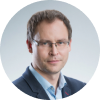The rush began with the world's largest banks in the USA, Europe and increasingly spread across the globe. Banks’ management was heavily investing the field, thinking whether this initiative is worth the money spent. Despite those doubts, the potential of Customer Experience products is enormous. The clue is in the right concept and implementation of the customer experience products.
The article was originally published on RetailTouchpoints. You can also read it here.
For the past several years the term ‘Customer loyalty’ has become a real trend almost in all spheres where business interacts with a customer: banking, retail, telecommunications, insurance, etc. Every business understands that the more new customers attracted and old ones retained, the higher is the ARPU.
The rush began with the world's largest banks in the USA, Europe and increasingly spread across the globe. Banks’ management was heavily investing the field, thinking whether this initiative is worth the money spent. Despite those doubts, the potential of Customer Experience products is enormous. The clue is in the right concept and implementation of the customer experience products.
Here are some of the examples successfully integrated into the existing banking ecosystems:
- Digital Marketing System
- Personal Finance Management (PFM)
- P2P transfers
- Multichannel approach
So, why those can be valuable for banks? Let`s go through some specifics.
Digital Marketing System
The solution provides bank employees with effective tools for monitoring and management of remote user behavior. Digital marketing system also allows creating targeted promotional marketing campaigns and manage ad banners for each particular user. Making the communication more personalized banks segregate audience by most basic factors: demographic, income, gender criteria and engagement level. This basic approach and terabytes of useful information allow banks to determine customers’ behavior and create more personalized offers.
Personal Finance Management (PFM)
How many people manage their budgets? How often they tools for budget management? And do they really need them? Most likely few people have time for that or do it manually thus spending lots of time on paperwork. PFM is an easily integrated system into any banking solution which can become a goldmine for your customers giving them an opportunity to automatically manage their budgets. It helps bank customers to track and categorize their expenses, set up goals and plan savings to reach them. I think you`ll agree that monitoring your expenses via random notes everywhere, but no in one place is a very good thing. Still, if you trust your bank using PFM is a sure-fire way to track expenses, while the bank has a great opportunity provide clients with more personalized and beneficial offerings.
Peer-2-Peer (P2P) transfers
Transferring money with a tweet or via Facebook messenger is a new reality of payments. In fact, UK Barclays Bank, Japanese Rakuten Bank, and a few other pioneers have enabled such an opportunity already. What about security concerns? In fact, it is quite secure. Before money is transferred user makes two-level authentication: FB User ID + password and One Time Password (OTP). After that, both sender and receiver get SMS and a Facebook notification. This solution is easily integrated into any banking system and makes payments a way simpler and natural for bank clients.
Multichannel approach
More channels, greater loyalty, more money
Communication channels play quite an important role in growing the level of customer loyalty. How banks talk to their clients and where they do it defines the level of customer engagement. Customers now handle more of their banking interactions via mobile devices, however, personal interaction remains quite valuable for customers. According to the study by Ernst & Young when it comes to important and costly initiatives customers still prefer to contact brick-and-mortar offices and talk to real people. So, why not combine all those channels to interact with customers better?
Go Mobile!
Mobile has become the dominant means for consumers to interact with their banks and a key element in the bid to earn customer loyalty. Customers completed more interactions with their banks via smartphones or tablets than through any other channel.
SMM
Social media have many faces: Facebook, Twitter, YouTube, Instagram and so on. Customers use them when they procrastinate or relax after a long working day and even at night watching cat videos. Why not take a chance and promote bank products there? Thus applying the multichannel approach helps banks to address customer needs of any taste at any place. This is critical for effective service, marketing, and selling because customers expect to be able to hop from one channel to another.
Conclusion
I guess you know that it costs 5-10 times more to get a new customer than to sell to a current one. Embracing a comprehensive Customer Loyalty Program is a smart investment into bank’s stability. Happy (loyal) customers are the valuable business asset that can and should be nurtured.

Contacts
Feel free to get in touch with us! Use this contact form for an ASAP response.
Call us at +44 151 528 8015
E-mail us at request@qulix.com





